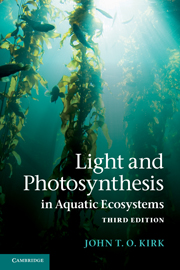Book contents
- Frontmatter
- Contents
- Preface to the third edition
- Part I The underwater light field
- 1 Concepts of hydrologic optics
- 2 Incident solar radiation
- 3 Absorption of light within the aquatic medium
- 4 Scattering of light within the aquatic medium
- 5 Characterizing the underwater light field
- 6 The nature of the underwater light field
- 7 Remote sensing of the aquatic environment
- Part II Photosynthesis in the aquatic environment
- References and author index
- Index to symbols
- Index to organisms
- Index to water bodies
- Subject index
- Plate Section
1 - Concepts of hydrologic optics
Published online by Cambridge University Press: 05 January 2013
- Frontmatter
- Contents
- Preface to the third edition
- Part I The underwater light field
- 1 Concepts of hydrologic optics
- 2 Incident solar radiation
- 3 Absorption of light within the aquatic medium
- 4 Scattering of light within the aquatic medium
- 5 Characterizing the underwater light field
- 6 The nature of the underwater light field
- 7 Remote sensing of the aquatic environment
- Part II Photosynthesis in the aquatic environment
- References and author index
- Index to symbols
- Index to organisms
- Index to water bodies
- Subject index
- Plate Section
Summary
Introduction
The purpose of the first part of this book is to describe and explain the behaviour of light in natural waters. The word ‘light’ in common parlance refers to radiation in that segment of the electromagnetic spectrum – about 400 to 700 μm to which the human eye is sensitive. Our prime concern is not with vision but with photosynthesis. Nevertheless, by a convenient coincidence, the waveband within which plants can photosynthesize corresponds approximately to that of human vision and so we may legitimately refer to the particular kind of solar radiation with which we are concerned simply as ‘light’.
Optics is that part of physics which deals with light. Since the behaviour of light is greatly affected by the nature of the medium through which it is passing, there are different branches of optics dealing with different kinds of physical systems. The relations between the different branches of the subject and of optics to fundamental physical theory are outlined diagrammatically in Fig. 1.1. Hydrologic optics is concerned with the behaviour of light in aquatic media. It can be subdivided into limnological and oceanographic optics according to whether fresh, inland or salty, marine waters are under consideration. Hydrologic optics has, however, up to now been mainly oceanographic in its orientation.
Information
- Type
- Chapter
- Information
- Light and Photosynthesis in Aquatic Ecosystems , pp. 3 - 27Publisher: Cambridge University PressPrint publication year: 2010
